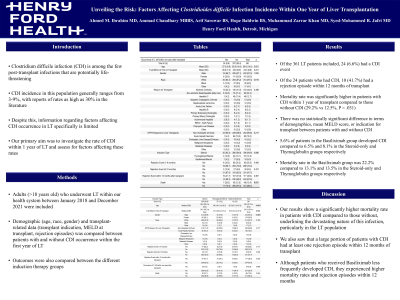Monday Poster Session
Category: Liver
P2387 - Unveiling the Risk: Factors Affecting Clostridioides difficile Infection Incidence Within One Year of Liver Transplantation
Monday, October 23, 2023
10:30 AM - 4:15 PM PT
Location: Exhibit Hall

Has Audio

Ahmed Ibrahim, MD
Henry Ford Hospital
Detroit, Michigan
Presenting Author(s)
Ahmed Ibrahim, MD1, Ammad Chaudhary, MD1, Arif Sarowar, BS2, Hope Baldwin, BS2, Muhammad Zarrar Khan, MD1, Syed-Mohammed Jafri, MD3
1Henry Ford Hospital, Detroit, MI; 2Wayne State University School of Medicine, Detroit, MI; 3Henry Ford Health System, Detroit, MI
Introduction: Of the multiple infections that liver transplant (LT) patients are vulnerable to, Clostridium difficile infection (CDI) is among the few that are potentially life-threatening. The incidence of CDI in this population generally ranges from 3-9%, with reports of rates as high as 30% in the literature. The risk of CDI is particularly high during the first year post-transplant when high-intensity immunosuppressive regimens are used in order to prevent transplant rejection. Despite this, information regarding factors affecting CDI occurrence in LT particularly is limited. Thus, this study aims to investigate the rate of CDI within 1 year of LT and assess for factors affecting these rates.
Methods: Adults ( >18 years old) who underwent LT within our health system between January 2018 and December 2021 were included in our study. Demographic (age, race, gender) and transplant-related data (transplant indication, MELD at transplant, induction therapy, rejection episodes) was compared between patients with and without CDI occurrence within the first year of LT. Outcomes were also compared between the different induction therapy groups.
Results: Of the 365 LT patients included, 30 (8.2%) had a CDI event. The mean age for those with CDI was 58.73 ± 9.16 years and 17 cases (56.6%) were men. Of the 30 patients who had CDI, 13 (43.3%) had a rejection episode within 1 year of transplant. There was no statistically significant difference in terms of demographics, mean MELD, or transplant indication between patients with and without CDI. However, mortality was significantly higher in patients with CDI within 1 year of transplant compared to those without (26.7% vs 12.8%, p=0.031). Regarding induction therapy, there was no significant difference in the odds of CDI or mortality when comparing the Basiliximab and Thymoglobulin groups to the Steroid-only group. However, there was a significant difference in the odds of rejection events in patients who received Basiliximab compared to those who received steroids only (OR = 3.19, 95% CI [1.249-8.823]).
Discussion: Our results show a significantly higher mortality rate in patients with CDI compared to those without, underlining the devastating nature of CDI in the LT population. We also note that a large portion of patients with CDI had at least one rejection event within 1 year of transplant. As far as induction therapy, although patients who received Basiliximab less frequently developed CDI, they were significantly more likely to develop rejection.
Disclosures:
Ahmed Ibrahim, MD1, Ammad Chaudhary, MD1, Arif Sarowar, BS2, Hope Baldwin, BS2, Muhammad Zarrar Khan, MD1, Syed-Mohammed Jafri, MD3. P2387 - Unveiling the Risk: Factors Affecting Clostridioides difficile Infection Incidence Within One Year of Liver Transplantation, ACG 2023 Annual Scientific Meeting Abstracts. Vancouver, BC, Canada: American College of Gastroenterology.
1Henry Ford Hospital, Detroit, MI; 2Wayne State University School of Medicine, Detroit, MI; 3Henry Ford Health System, Detroit, MI
Introduction: Of the multiple infections that liver transplant (LT) patients are vulnerable to, Clostridium difficile infection (CDI) is among the few that are potentially life-threatening. The incidence of CDI in this population generally ranges from 3-9%, with reports of rates as high as 30% in the literature. The risk of CDI is particularly high during the first year post-transplant when high-intensity immunosuppressive regimens are used in order to prevent transplant rejection. Despite this, information regarding factors affecting CDI occurrence in LT particularly is limited. Thus, this study aims to investigate the rate of CDI within 1 year of LT and assess for factors affecting these rates.
Methods: Adults ( >18 years old) who underwent LT within our health system between January 2018 and December 2021 were included in our study. Demographic (age, race, gender) and transplant-related data (transplant indication, MELD at transplant, induction therapy, rejection episodes) was compared between patients with and without CDI occurrence within the first year of LT. Outcomes were also compared between the different induction therapy groups.
Results: Of the 365 LT patients included, 30 (8.2%) had a CDI event. The mean age for those with CDI was 58.73 ± 9.16 years and 17 cases (56.6%) were men. Of the 30 patients who had CDI, 13 (43.3%) had a rejection episode within 1 year of transplant. There was no statistically significant difference in terms of demographics, mean MELD, or transplant indication between patients with and without CDI. However, mortality was significantly higher in patients with CDI within 1 year of transplant compared to those without (26.7% vs 12.8%, p=0.031). Regarding induction therapy, there was no significant difference in the odds of CDI or mortality when comparing the Basiliximab and Thymoglobulin groups to the Steroid-only group. However, there was a significant difference in the odds of rejection events in patients who received Basiliximab compared to those who received steroids only (OR = 3.19, 95% CI [1.249-8.823]).
Discussion: Our results show a significantly higher mortality rate in patients with CDI compared to those without, underlining the devastating nature of CDI in the LT population. We also note that a large portion of patients with CDI had at least one rejection event within 1 year of transplant. As far as induction therapy, although patients who received Basiliximab less frequently developed CDI, they were significantly more likely to develop rejection.
Disclosures:
Ahmed Ibrahim indicated no relevant financial relationships.
Ammad Chaudhary indicated no relevant financial relationships.
Arif Sarowar indicated no relevant financial relationships.
Hope Baldwin indicated no relevant financial relationships.
Muhammad Zarrar Khan indicated no relevant financial relationships.
Syed-Mohammed Jafri: Gilead, Takeda, Abbvie – Advisor or Review Panel Member, Speakers Bureau.
Ahmed Ibrahim, MD1, Ammad Chaudhary, MD1, Arif Sarowar, BS2, Hope Baldwin, BS2, Muhammad Zarrar Khan, MD1, Syed-Mohammed Jafri, MD3. P2387 - Unveiling the Risk: Factors Affecting Clostridioides difficile Infection Incidence Within One Year of Liver Transplantation, ACG 2023 Annual Scientific Meeting Abstracts. Vancouver, BC, Canada: American College of Gastroenterology.
